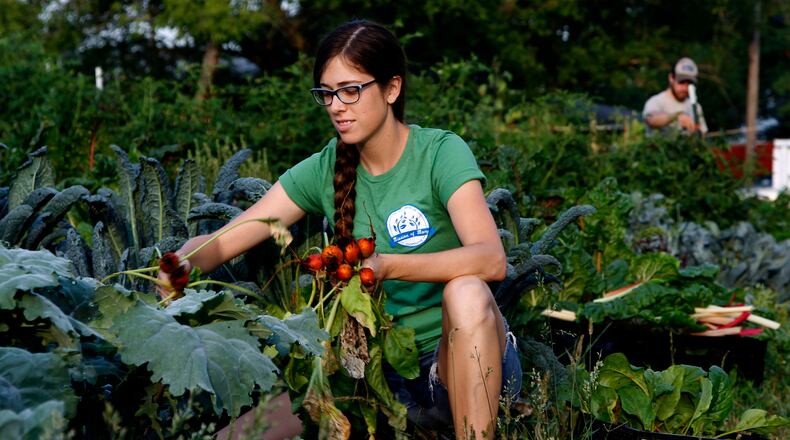The city of Dayton has enacted policies to reduce the costs of starting a garden. MetroParks offers technical assistance, training and education to gardeners.
Officials say community gardens and urban agriculture promote better eating habits. They also build relationships between neighbors and return vacant and abandoned lots to productive use.
Gardens are showing up in neighborhoods where access to nutritious food is limited or virtually nonexistent.
“Community gardens are a good reuse of vacant land,” said Aaron Sorell, Dayton’s director of planning and community development. “It provides a great opportunity for neighbors to come together and get to know each other, and folks in a lot of Dayton neighborhoods may not have backyards for a garden for fresh vegetables.”
In the last seven years, there has been significant increase in gardens in this region, as interest in locally grown food and urban agriculture has blossomed, said Luci Beachdell, MetroParks’ community gardens supervisor.
“There has been a huge food movement in that time, and that makes a big difference,” Beachdell said.
MetroParks gives residents advice about what type of garden to create, how it can operate and what gardeners can expect during the growing process.
The organization also provides education and limited physical support, including a seed-giveaway in the spring. The bulk of community gardens are in Dayton, but the MetroParks program serves all of Montgomery County.
“MetroParks offers lots and lots of gardening programs for people,” Beachdell said. “We till some of the gardens, but as we’ve increased in size, we can’t always keep up with that demand.”
There are various types of community gardens.
Some allow gardeners to rent small, individual plots. Others are communal in nature, where gardeners work together to raise food that they divide up.
Some gardens grow produce for charity purposes. Some are run by churches, food pantries and other nonprofit groups.
“You can build a garden on a shoe-string budget, or you can build a really expensive garden, or you can do a whole lot of stuff in between,” Beachdell said. “It depends on who your people are, what kind of garden you want, what it looks like and what your goals are.”
Mission of Mary Cooperative is a faith-based nonprofit that works in the Twin Towers neighborhood to turn vacant lots into productive and beautiful garden spaces, said Stephen Mackell, the group’s farm manager.
Mission of Mary runs three gardens, including one on Hawker Street, which it built last fall and planted this year, Mackell said.
Mission of Mary staff manage its plots and handle growing responsibilities. The organization hosts a twice-weekly street market and provides community meals. Staff also distribute fresh produce to about 50 families, who pay a fee for membership. Families who receive food stamp benefits pay discounted fees.
“We raise organic produce and distribute it three different ways to people in the neighborhood,” Mackell said. “People who pay the membership fee get around 10 to 15 pounds of food every week throughout the season.”
Before the garden was built on Hawker Street, the property contained two abandoned homes, which were knocked down by the city after they were destroyed by a fire last year.
Installing a garden has eliminated an eyesore and has helped improve the character of the Twin Towers neighborhood, which continues to struggle with crime, mostly illegal drug activity, said Rey Ybanez, 44, who lives nearby.
“It’s a little bit better than it was before,” he said.
Ybanez also said the garden definitely makes it easier for local residents to buy fresh vegetables, which he says are far tastier and healthier than processed food. He said not many residents in the neighborhood have their own gardens.
The foodie movement has become more mainstream. And the city of Dayton has made it easier to get involved in urban crop-raising, with the goal of promoting nutrition and relationship building.
Community gardens have cropped up in parts of the city classified as food deserts by the U.S. Department of Agriculture, because they lack access to fresh, healthy and affordable food.
In 2013, the city began offering grants worth as much as $500 to help reduce water service costs for community gardens. The city also provides grants worth as much as $2,000 to help pay to install water service at the sites.
The city also changed its zoning rules in 2010 to make it easier to compost on site. Additionally, the city split water and sewer residential bills apart for community gardens so they will not be billed for sewer charges they do not use, Sorrell said.
Earlier this summer, Dayton commissioners approved providing $160,000 in community block grant funds to the Ohio State University Extension for the Vacant to Vibrant urban agriculture and nutrition project.
The project, which began in 2009, helps provide fresh produce to inner-city families by transforming vacant properties into green space. One lot in 2012 provided more than 600 pounds of fresh produce for donation to an adjacent food pantry.
The grant will expand the program to create four additional green spaces to increase production of local foods, said Tim Riordan, Dayton city manager.
The money will pay for infrastructure improvements to extend the growing season by at least two to three months. Improvements may include frost blankets, high tunnels, mini tunnels and raised beds.
The spaces will be at Helena and Main streets; Alaska Street and the Edgemont Solar Gardens at 919 Miami Chapel Road. A fourth site will likely be on Delphos Avenue.
The goal is to “increase our production of local foods so we can do it year round,” Riordan said.
About the Author

